Where Bubba Gets His Power From
- by Kelvin Miyahira
The April 2009 issue of Golf Digest magazine has a nice layout of the PGA tour’s driving distance leader, Bubba Watson. Bubba’s swing is pure athleticism since he is self-taught and not “tainted” by golf instruction. He has a great transition and fires on the chi line as an elite athlete would naturally do.
But what is even more curious is the analysis by the Rick Smith. Here are a few quotes from the first two paragraphs.
“But when you see it in super –slow motion – oh, my – there are things he does that seem to defy biomechanics.” So he goes on to elaborate. “For instance, he makes a distinct move toward the target before he has completed his backswing. You read that right: The club is going backward while he’s going forward. Imagine how much torque that creates.”
Does it make sense now that this is the guy that dismantled everything athletic about Phil Mickelson’s swing and left him with nothing but a short game to rely on? Thank goodness Butch is making progress on bringing back the athleticism to Phil.
Smith goes on to say how awesome his leg action is and that “both feet literally spring upward as he hits the ball.” Welcome to the real world.
Anyway, here’s my take on Bubba’s great athletic swing. But first some background information to lay the foundation for my theory.
The Spine Engine
Dr. Serge Gracovetsky, a mathematician and physicist, developed the idea of the spinal engine based on his “non-clinical” research of his own back pain. (He went to seven different doctors, got seven different diagnoses and therefore decided that everyone was incompetent and did not to let anyone touch his back.)
The concept of a spine engine is really quite simple. Gracovetsky utilizes a lizard’s body in his analogy. A lizard’s spine wiggles from side to side and then the legs move. According to Gracovetsky, the movement of the legs is just an expression of the spine engine’s movements. This is evidenced in humans who have no legs but who are able to “walk” by wiggling their spine. So it is his theory that all locomotion in our body is as a result of the spine engine.
If that is true, then how is a golf swing performed? By moving your arms? By your shoulders? Your hips? Or is it by the musculature that is connected to your spine and behind you?
Well, it seems Tiger, Bubba and Jamie all know how to use their spinal engines while the majority of us don’t. So let’s dig deeper so we can try to understand how to hit the ball farther and use our bodies more effectively.
“X” marks the spot!!!
What is incredibly important for everyone to understand is how the muscles are connected. Without getting too deep into muscle insertion points and origins, humans have an intricate pattern of muscles laid out in angles that are well suited to do of all things…..wiggle and rotate.
The reason? Your glutes are also contralaterally connected to your lats. In other words, your left glute is cross-connected to your right latissimus. And your right glute is connected to your left lat. Take a look at the picture below where the big “X” has been drawn.
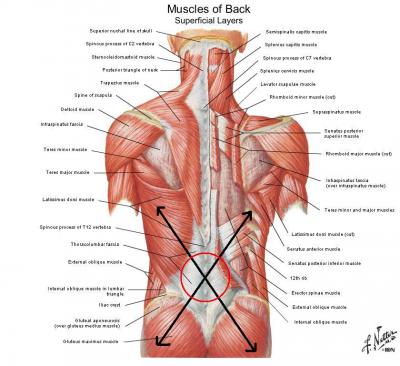
What does this mean to your golf swing? If you perform a naturally athletic motion, your body should naturally rotate around your spine. Hence the chi line movements that we see in the best players. The chi line movements are a result of a balanced left/right side musculature moving around the spine in synchrony.
But that’s not all there is. Just as a cat prepares to pounce on an unsuspecting bird, golfers can compress their spine engines so it can spring upward. Add these two movements together and you have the same movements as an ice skater that must dip down, create counter rotation before doing a triple loop.
In fact, Michelle Kwan the great Olympic figure skater is a natural at golf. Here’s her quote from the Dailybreeze.com interview, ‘"I think I pull my arms up the same way I did in skating," Kwan said as she showed how jerking her arms up in the backswing was like the start of a salchow.’
The bottom line is that at the very core, athletic movements in different sports begin to look similar. So let’s just learn what these movements are. To understand the spine engine and how it produces movement, let’s look at the golf swing from a totally different perspective, the back view. In my next article, I’ll look at the things golfers do to destroy the natural movements of the spine engine.
Who ya gonna call? Mythbusters!
A funny thing happened on the way to the lab. We learned something. While doing some research on the spine engine, I took a lot of videos of pros from the back view. But instead of looking at the average tour pro, I decided that I should seek to understand how the longest hitter on tour, Bubba Watson does it. And what I learned is incredible.
So let me start with a question. How many of you believe in the kinetic chain? In other words, the swing should start from the ground up. That one should start with the legs, then to the hips, then to the shoulders, out to the arms and finally out to the club. Sounds logical, so it must be right.
Not so fast. There’s ample evidence to question this idea.
I’ve drawn three lines; at Bubba’s lead leg, his arms as he is finishing the backswing and his belt line. Take a look.
For four frames during transition, his legs do not really move while he is completing his backswing. Yet his spine has compressed down and this lowers his belt line besides moving him laterally. There is a noticeable tilt of his hips as well. The similarity to Jamie Sadlowski’s transition is pretty amazing in this regard.
Thinking of the spine engine and how it creates motion, I thought back to the illusion of the closed hip bump. I used to think it was due to the legs. After viewing this, NO WAY!!!
Instead of viewing this as starting from legs in an active driving move, I believe this is more like playing musical chairs and trying to sit down fast by releasing tension from your legs so you can fall faster.
Feel Test
Try this test. Stand without a golf club (and no one watching). Do your backswing and then try to buckle your left knee to allow your spine to drop an inch, and then stop the fall abruptly. After dropping, stop suddenly and you’ll feel a jolt that’s the trigger for the 2nd fire.
Next, try doing your backswing again but this time, try to push off your right leg and shift your weight to the left. What you might find is that will not allow you to drop as much nor drop your arms in the slot.
In both methods weight moves to the front leg similarly. BUT, by using your right leg to push, it causes your entire body to rotate and your hands will want to move out and over the correct plane. Get it???
Bubba’s Drop
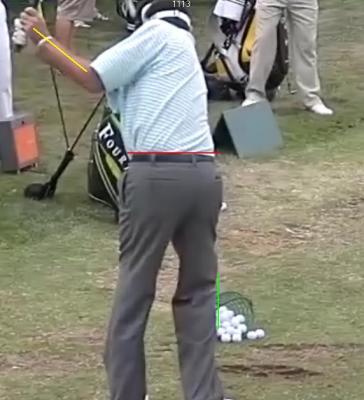
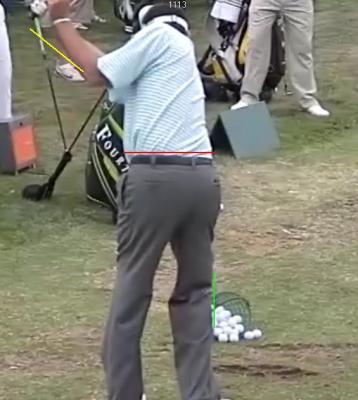

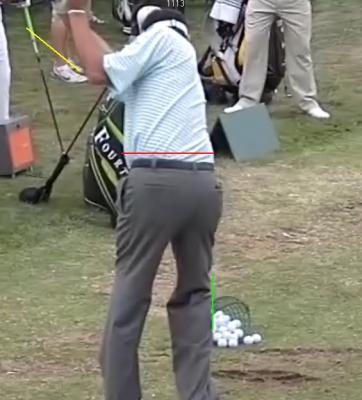
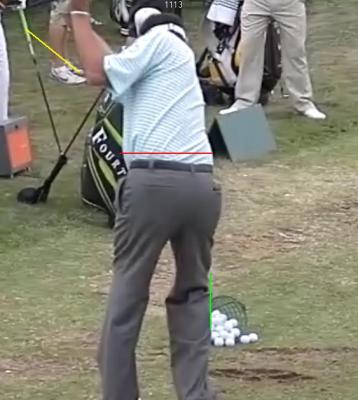
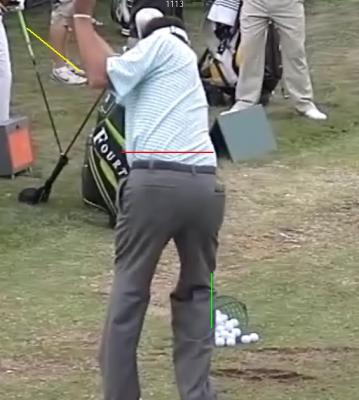
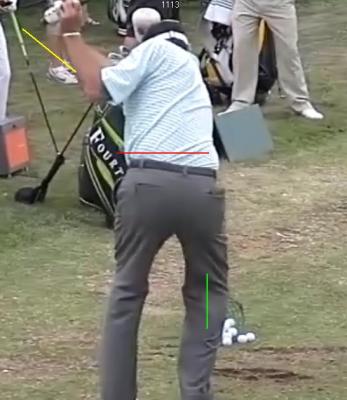
So only at the 5th frame do we begin to see Bubba’s lead knee move beyond the green line. By the 6th frame, he’s completed his transition and is about ready to unleash the fury.
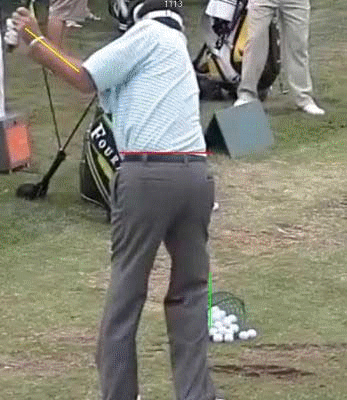
Given this view, is this leg driven or spine engine driven?
Also, his body is holding a tremendous amount of coiling in his body. Just look at his shirt creases and you can see there is some X-Factor stretch. Moreover, there is a long diagonal crease and associated scrunching of his torso via a relatively unknown scapula move. This extremely important move will be tackled in another article that will be dedicated to this move.
Hocus Focus
Just as we are so “plane obsessed” in viewing the golf swing, we are also “front view obsessed.“ We want to see the hands, the club, the leg drive and more. So to show you how difficult this type of analysis can be, let’s take a look at Bubba’s swing from two angles simultaneously so you can see how video can fool you.

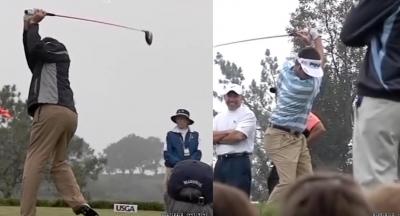
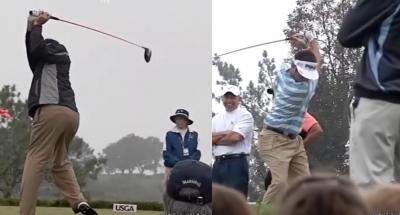
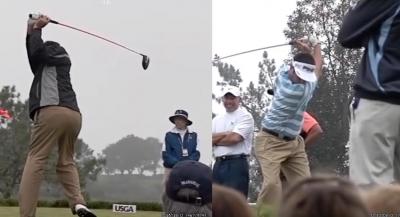
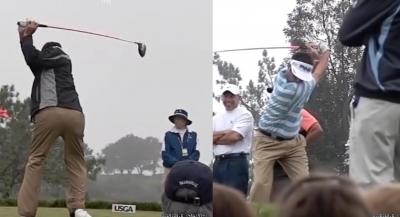
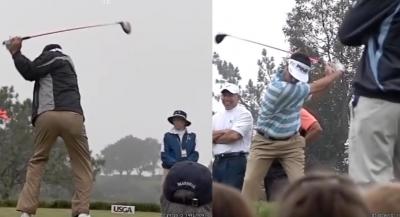
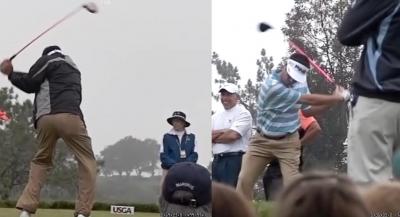
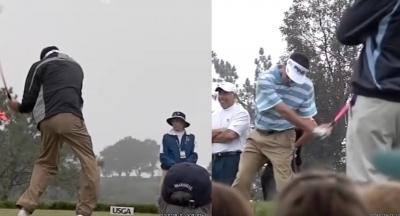
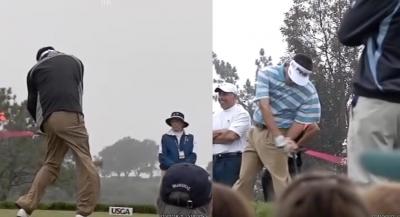
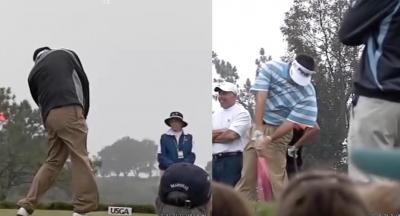

At this point, Bubba is just about to start his powerful transition.
Back View
He’s just finishing his transition. From the back view that we looked at before, we know that his lower body has made three important moves; shifted to the front foot, compressed his spine and rotated a little while the upper body was held back. Bubba’s lateral hip motion can be seen by looking at Steve Williams (Tiger’s caddy) white shirt relative to Bubba’s hip.
Front View
But from the front view, the legs and hips look so much more dynamic. It gives the illusion that the motion has started in his legs, transferred to his hips and up the kinetic chain.
So what’s driving the swing? Is it the legs, hips, shoulders or spine engine? Read on.
The 2nd Fire
The 2nd fire starts right after the transition is complete. One can clearly see from both angles how dynamic Bubba is. Of course you can see he’s right on the chi line. He’s definitely not in front or past the chi line. But from front view, there is a greater tendency to see more of what the shoulders and arms are doing.
Imagine how much built up torque he has created in his body at this point. If he stopped his lead leg at this point or drove past the chi line, what would happen to his spine engine? His lead glute and rear lat would slow down.
Not having the power from that huge power source where would or could he get the power from? A harder driving lead lat and shoulder? What kind of a swing does that sound like? Tiger’s new swing???
Or he could get more power from his right leg and glute. Does that sound like a hip thrusting, spine angle losing, stand up through impact type of swing?
Bubba displays a balance of power between the right and left side of his body due to his reliance on the spine engine, which naturally moves around the chi line. Thus, we don’t see the left side stopping while the right side is hitting as it typical for the amateurs.
The bottom line is that if you’re only looking at your swing from the front view, you’re missing a lot of information.
Target line view
So let’s take a look at the target line view to see what interesting things we can find from that angle. But first, can we stop looking at the plane?
Here’s Bubba’s swing looking down the target line. The first photo is of him right after transition and he’s ready to fire.
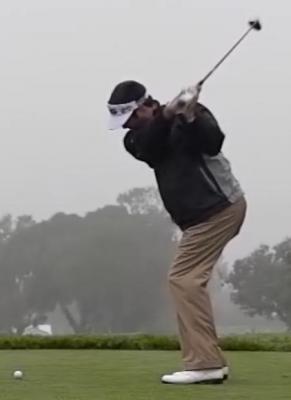

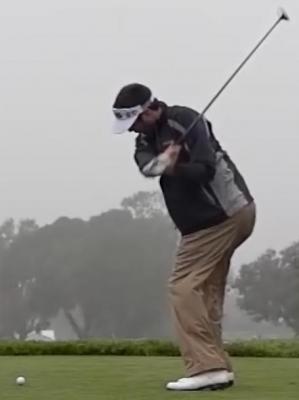
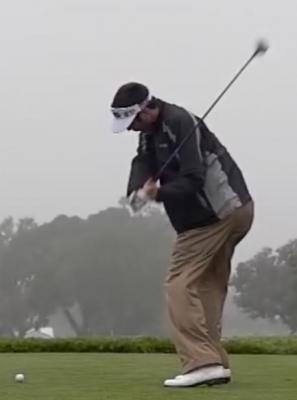
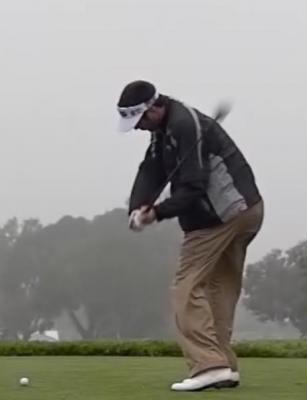
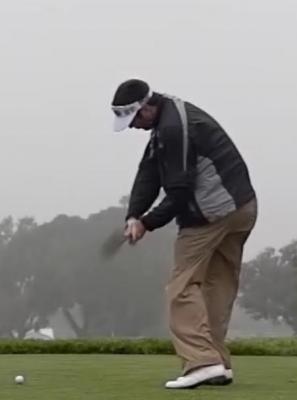
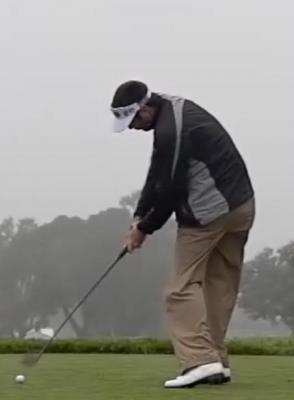
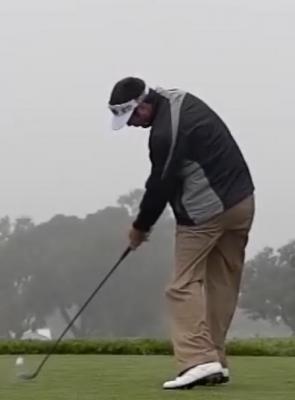
One can clearly see how his hips are clearing and opening. But instead of using those terms, think of how he is moving his spine engine. He’s firing his glutes and erectors to create this movement.
When his shaft is about horizontal, look at his shoulders. They are about square to the target now. Yet, his hips are way open already. Look how rounded his back is. That is a sure sign of his erector spinae (erectors are those long muscles that run up and down the sides of your spine), right lat muscle and glutes are firing like crazy.
Given what we are seeing here, a good question comes to mind. What exactly are the shoulders doing? Jim McLean once suggested that the shoulders should catch up to the hips near impact. Is this what’s happening?
What about the kinetic chain? Did the hips decelerate to transfer energy and speed to the shoulders? Did the shoulders fire, as they should somewhere in the middle of the downswing as the “model” kinetic chain graphs depict? Did the shoulders decelerate to transfer energy and speed to the arms? Am I missing something here? I don’t know about you, but I don’t see this happening.
Or is it more likely that the spine engine truly drives the swing and the hips and shoulders merely represent the easiest markers or indicators of the human body. So it is understandable to make them your markers. But to take it one step further and say that the shoulders and the hips are doing this or that to drive the swing…………that isn’t right.
Okay, I can hear the naysayers already. But I’ve got more ammo or shall I call it a rocket launcher?
Take a look at Jamie Sadlowski’s swing from the target line.
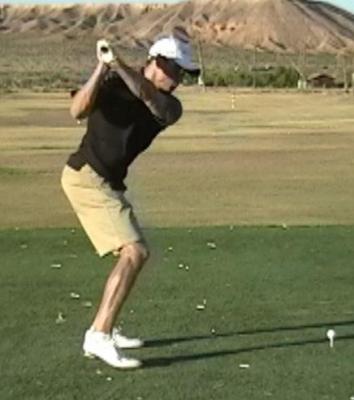
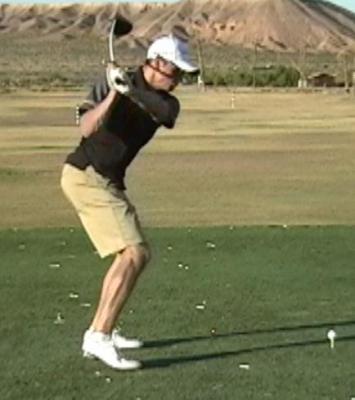
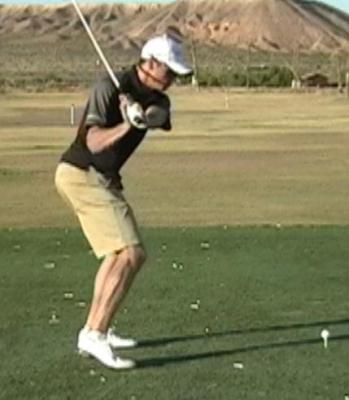
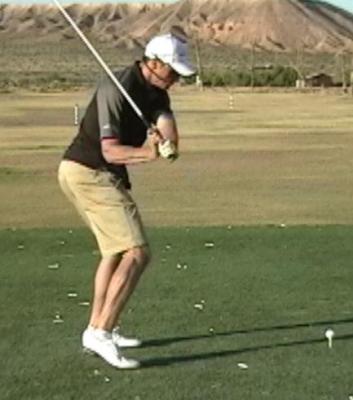

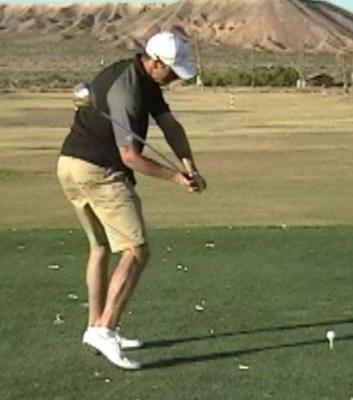
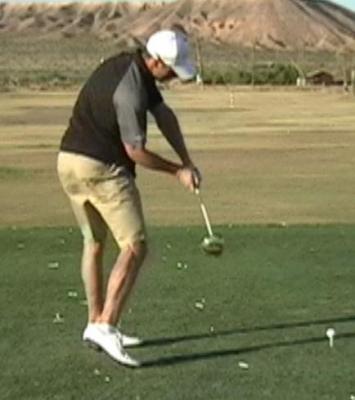
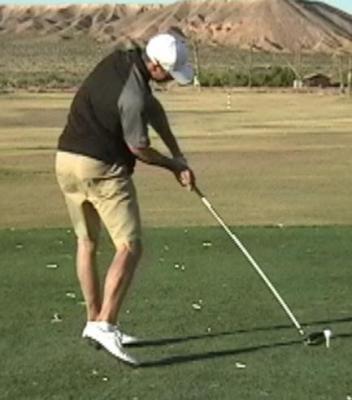
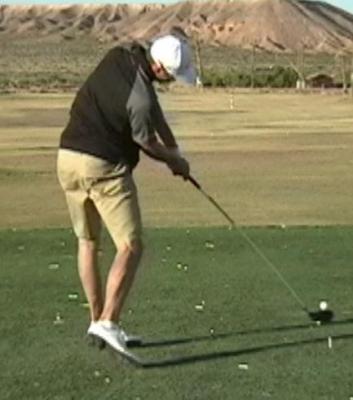
Do an isometric exercise. Stand facing a door. Grab the knob with both hands and try to move your spine engine. Turn your spine so that it straightens your left leg and feel how much force you can put into the knob.
Next, try pushing with your right side while pulling on the handle. Your hips, when doing the wrong move, typically thrusts out towards the ball while the spine straightens vertically.
Other Realities
Hopefully, this will open your eyes to the “other realities” that exist. And perhaps a whole new language must be developed to identify, characterize and classify some of these moves without using the “chosen” markers as our guides. Even my own terms like closed hip bump and jump/twist may need to be renamed to emphasize the spine engine’s influence in driving the swing.
There are other extremely important moves that the spine engine is making involving the scapula, the lats and the abdominals role in all of this. And discussing dysfunctional moves in light of this new evidence will be part of another article. But for now, try to experiment with some of the moves while thinking of how your spine engine is moving. It could be the start of something quite miraculous.

